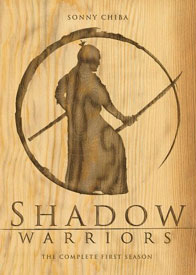 The semi-legendary Iga ninja Hattori Hanzo (1541-1596) appears in sundry films, anime, manga, video games, & in the television series Kage no Gundan (Shadow Warriors, 1980-1985), wherein Hanzo was played by Shinichi Chiba.
The semi-legendary Iga ninja Hattori Hanzo (1541-1596) appears in sundry films, anime, manga, video games, & in the television series Kage no Gundan (Shadow Warriors, 1980-1985), wherein Hanzo was played by Shinichi Chiba.
The television series was also the last hurrah for the Japan Action Club, a teen-oriented stunt-man & stunt-woman training ground of young would-be actors, most of whom never broke out of the background stunt roles.
The exceptions were Etsuko Shiumi & Hiroyuki Sanada, who played major roles in the television series. Sanada would go on to become a world-class actor in such great films as Twilight Samurai (Tasogare Seibei, 2002), but in his Action Club days he seemed no more than a teen idol.
The general framework for the first season of the series is the history of the Hattori family, who were shadow-spies for Ieyasu Tokugawa, but became outcast from the shogunate in the time of Ietsuna Tokugawa, the fourth shogun.
Chiba used to do a magic act live on stage & could not resist making his Action Club ninjas capable of "actual" magic, so there is a children's series tone with plenty of comedy interludes.
But at the same time, however, the series pushes the envelope with as much gore & semi-nudity as could get past the censors in the '80s, so the childishness becomes more adolescently childish rather than appropriate for children.
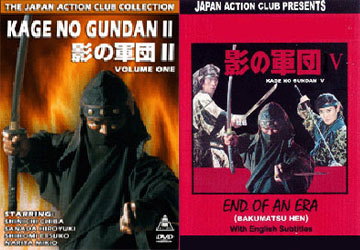 In season one, Chiba plays the third generation clan patriarch of Iga spies, Hanzo III, attempts here & there to act with great emotion, but the real point of the series is to highlight the Action Club's acrobatics & Chiba's exciting if often cartoonish fight choreography. In season one, Chiba plays the third generation clan patriarch of Iga spies, Hanzo III, attempts here & there to act with great emotion, but the real point of the series is to highlight the Action Club's acrobatics & Chiba's exciting if often cartoonish fight choreography.
Season by season, the generations of the Hattori family are chronicled.
These break down into Hattori Hanzo: Kage no Gundan, twenty-seven episodes (1980); Kage no Gundan II, twenty-six episodes (1981-1982); Kage no Gundan III, twenty-six episodes (1982); & Kage no Gundan IV: Bakumatsu-hen, forty episodes (1985).
In the second season (1981-82) Chiba plays Shinpachi Tsuga of the Iga, posing as a restauranteer (rather than bathhouse manager as in season one), while continuing the shadow-war against Koga ninja.
In the third season episodes (1982) he plays Hanzo Tarao. By the fourth/final season (1985), we've reached the Bakumatsu era at the time of the last Tokugawa shogun, with Chiba playing Hanzo Hattori XV.
In Kill Bill (2003), the old swordmaster played by Chiba is given the name of this famous character, as a nod to one of Quentin Tarrantino's influences. For many years the series was a cult favorite in the west among an extensive "underground" of Asian action fans, including Tarrantino, who had to settle for fuzzy bootleg vhs or dvd copies recorded off Hawaiian television. The entire first season is now available in an official release, with removable subtitles. Later seasons are still in circulation primarily as bootlegs.
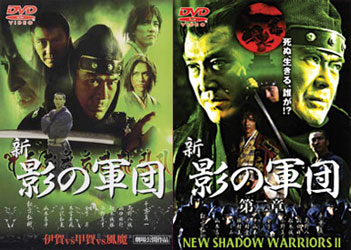 The television series is quite the opposite of the classic ninjas of the Shinobi no mono series starring Raizo Ichikawa. The television series is quite the opposite of the classic ninjas of the Shinobi no mono series starring Raizo Ichikawa.
In leftist director Satsuo Yamamoto's first feature film in that superb series, Shinobi no mono (Daiei, 1963), Hanzo was played earnestly by Saburo Date.
And in Norifumi Suzuki's Shogun's Ninja (Ninja bugeicho momochi sandayu, 1980) Hanzo is played by Isao Natsuyagi. He crops up as a character in many other films.
But Sonny Chiba so wholly absorbed the role that he came to be associated more intensely with only one other role, that of another legendary ninja, Yagyu Jubei.
A crustier Chiba starred in a set of direct-to-video cheapo actioners, Shin Kage no Gundan (The New Shadow Warriors, 2003 series). In the second of these six shortish widescreen features, Iga ninja break into three bands, each responsible for getting three versions of Princess Fuji (not knowing which one is real) safely to her wedding.
These were fairly standard "Koga ninja versus Iga ninja" stories. They are "prequels" to season one of the television series, with Chiba playing Hanzo II. The titles for the whole series are:
Shin kage no gundan (New Shadow Warriors 1, 2003); Shin kage no gundan: Dai no sho (New Shadow Warriors 2, 2003); Shin kage no gundan: Dai no sho Jiraika (New Shadow Warriors 4: Jiraika 1, 2003); Shin kage no gundan: Jiraika dai yon sho (New Shadow Warriors 4: Jiraika 2, 2003); Shin kage no gundan: Dai go sho Hattori Hanzo to Onmyoji (New Shadow Warriors 5: Hanzo Hattori vs Onmyoji, 2003); & Shin kage no gundan: Saishu-sho Hattori Hanzo saigo no tatakai (New Shadow Warriors: The Final Chapter, 2003).
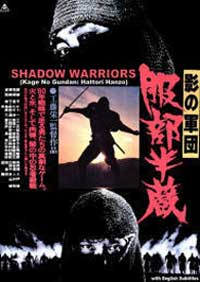 Eiichi Kudo's widescreen color epic Kage no Gundan Hattori Hanzo (Hanzo hattori: Samurai Shadows aka Shadow Warriors, Toei, 1979) started the Hanzo phenomenon in the clan's first generation, but without Shinichi Chiba. Eiichi Kudo's widescreen color epic Kage no Gundan Hattori Hanzo (Hanzo hattori: Samurai Shadows aka Shadow Warriors, Toei, 1979) started the Hanzo phenomenon in the clan's first generation, but without Shinichi Chiba.
It stars Teruhiko Saigo & Tsunehiko Watase as Upper & Lower Hanzo, one who lives in the light, the other in darkness. I'd label it a "tableau film" since many set-ups look great, but there is only a little bit of plotting about the Iga ninja Hanjo with Lord Matsudaira. The historical excuse for the action is the death of Iemitsu Tokugawa, inducing a power struggle for rule of Japan.
Despite saving graces the film is sometimes laughable. Set in the mid-1600s & usually serious in acting style & overall tone, nevertheless an overlong scene of outrageous campiness overshadows the rest of the film. Ninjas dress up in football helmets & shoulder padding & proceed to play football-slaughter, going into huddles, tackling.
It's fun but truly stupid & it's filmed without much real humor as though with the mistaken impression that the very idea was so neato kean-o-winks & kool that it didn't need anything else to be oh so witty.
Treatment of women in the script is equally assinine. Perhaps somewhere in the world at some point in history the stereotyp that is common only in cinema -- of the woman who falls in love with her violent rapist -- actually exists. Supposing this psychology were believable, the biology of the thing is not, as the rape victim who falls for her attacker realizes she's pregnant in a mere week, & tries to beat the week-old critter to death by wacking her belly with a rock.
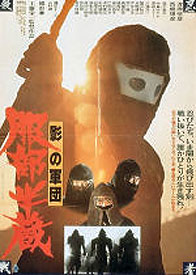 Then there's the youth-interest of the Japan Action Club all of whom look particularly foolish & out of place in the background cast. Then there's the youth-interest of the Japan Action Club all of whom look particularly foolish & out of place in the background cast.
But for all its many great faults, there are more than a few moments in the film that sparkle & are fairly involving. Now & then a really interesting character appears, such as the down & out lowbrow yakuza played by Mikio Narita. Shadow Warriors can be enjoyable just so long as one is not expecting something that at least tries to imitate classic jidai-geki period films.
The tale takes place after the death of Iemitsu the third Tokugawa shogun, when ronin or were expelled from Edo, the military capital. The child shogun Ietsuna is kidnapped but turns out to be hidden under (or over) everyone's noses in a castle turret which is reinforced by a comic book villain, the fire-spitting black ninja. The good ninja has to get through all the traps & save the child.
Some good cinematography & the gorgeous standing sets recycled through many samurai films & even the goofy ninja antics do make for an exciting if non-sensical gore-fest at the climax.
copyright © by Paghat the Ratgirl
|
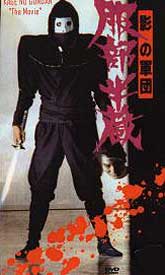

 In season one, Chiba plays the third generation clan patriarch of Iga spies, Hanzo III, attempts here & there to act with great emotion, but the real point of the series is to highlight the Action Club's acrobatics & Chiba's exciting if often cartoonish fight choreography.
In season one, Chiba plays the third generation clan patriarch of Iga spies, Hanzo III, attempts here & there to act with great emotion, but the real point of the series is to highlight the Action Club's acrobatics & Chiba's exciting if often cartoonish fight choreography. The television series is quite the opposite of the classic ninjas of the Shinobi no mono series starring Raizo Ichikawa.
The television series is quite the opposite of the classic ninjas of the Shinobi no mono series starring Raizo Ichikawa.
 Then there's the youth-interest of the Japan Action Club all of whom look particularly foolish & out of place in the background cast.
Then there's the youth-interest of the Japan Action Club all of whom look particularly foolish & out of place in the background cast.